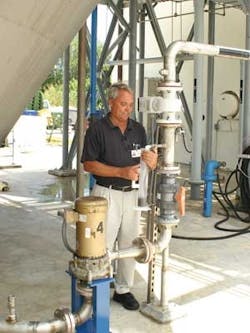Partnership to monitor oil, gas releases in Gulf of Mexico, Florida Keys
ATLANTA, GA, Apr. 28, 2011 -- ITT Corporation's AADI brand has teamed up with the University of North Carolina (UNC) at Chapel Hill to develop two new multi-sensor arrays to detect light hydrocarbons and oxygen depletion, conditions associated with oil and gas releases. This research is vital to monitor the long-term effects of water contamination and its threat to coral reef and other coastal ecosystems.
The multi-sensor arrays, built on AADI's SEAGUARD platform, have enabled scientists in the University's Department of Marine Sciences to set new standards for the efficiency of analyses while offering unmatched precision and simple deployment.
The multi-parameter instrument offers advanced flexibility and real-time capabilities for underwater observation. The first of the new arrays developed from the platform, nicknamed HANDI by the UNC-Chapel Hill scientists, was deployed for testing in 2010 at Conch Reef off Key Largo, Florida. The array assisted the team by effectively detecting oxygen depletion and potential oil and gas transport along the reef ecosystem's border with fast-moving water in the Florida Straits. Equipped with two of AADI's fast-response optodes from ITT Analytics, HANDI offers the team immediate and reliable dissolved oxygen measurements without the need for repeated calibrations.
Following the success of the system in Florida, HANDI has been redeployed as part of a benthic lander system with oxygen and light hydrocarbon monitoring capabilities in the northern Gulf of Mexico. The deployment forms part of a long-term gas hydrate monitoring program at Mississippi Canyon Block 118 located within 20 miles of the Deepwater Horizon oil and gas blow-out. The SEAGUARD platform also offers UNC-Chapel Hill scientists the possibility to add a multi-sensor string, which can turn a single system into a large-scale array simply by plugging in a string of up to 60 sensors.
"The Department of Marine Sciences' work with ITT Analytics' AADI SEAGUARD platform has revealed numerous advantages including easy deployment, high system reliability and high fidelity as well as unparalleled precision of the data recorded," said Dr. Chris Martens, Distinguished Professor of Marine Sciences at UNC-Chapel Hill. "In addition, ease of system configuration is a significant plus which enables us to combine, add, remove and redistribute sensors or strings of multiple sensors based on the needs of individual sampling protocols."
The second SEAGUARD multi-sensor array known as GHANDI, has been designed as a survey instrument and was deployed during UNC-Chapel Hill's Florida Keys mission to survey spatial variability in background light hydrocarbon distributions along the outer reef track. The system's range of AADI sensors monitor oxygen, current conditions, water temperature and conductivity, offering UNC-Chapel Hill's scientists the flexibility to easily adapt the configuration to meet various demands at each stage of the program.
In addition to deploying these two new SEAGUARD platforms, UNC-Chapel Hill marine scientists also collected continuous oxygen and temperature data on a living coral reef in the Florida Keys using a SEAGUARD string system. The system features major design breakthroughs that allow direct, simultaneous monitoring and logging of ambient dissolved oxygen and benthic respiration. Equipped with a 170 meter long string and ten of AADI's 4330F fast response optode sensors, the system collects data every 30 seconds and sends it via radio to on-shore laboratories in near real time, allowing continuous live observations on the seafloor.
###

